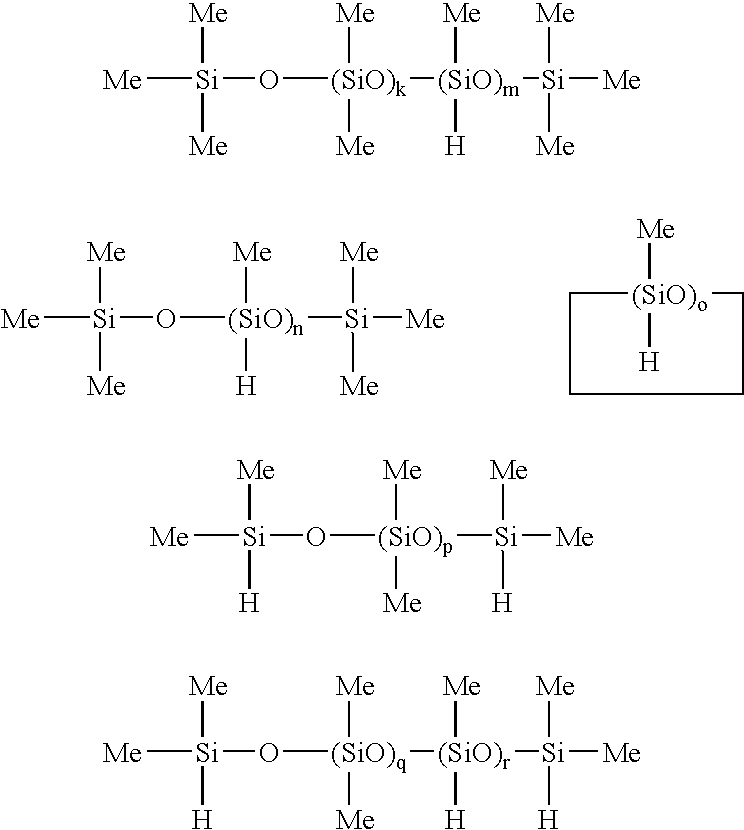Electroconductive silicone pressure-sensitive adhesive composition
a technology of pressure-sensitive adhesives and silicone rubber, which is applied in the direction of metal/alloy conductors, non-metal conductors, conductors, etc., can solve the problems of not being able to achieve grounding or similar purposes, pressure-sensitive adhesives cannot withstand the high temperature of soldering, and achieve stable conductivity and adhesive properties. , the effect of satisfying the adhesion of silicone rubber
- Summary
- Abstract
- Description
- Claims
- Application Information
AI Technical Summary
Benefits of technology
Problems solved by technology
Method used
Image
Examples
synthesis example 1
Synthesis of Silicon-base Compound (Polysilane)
[0075]Phenylhydrogenpolysilane (abbreviated as PPHS, hereinafter) was prepared by the following procedure.
[0076]In an argon-purged flask, methyl lithium in diethyl ether was added to a THF solution of bis(cyclopentadienyl)dichlorozirconium. By effecting reaction at room temperature for 30 minutes and distilling off the solvent in vacuum, a catalyst was prepared in situ. To the catalyst, phenyltrihydrosilane was added in a molar amount of 10,000 times the moles of the catalyst. With stirring continued, the mixture was heated at 100–150° C. for 3 hours and then at 200° C. for 8 hours. The resulting product was dissolved in toluene and washed with aqueous hydrochloric acid for deactivating and removing the catalyst. Magnesium sulfate was added to the toluene solution to remove the water, followed by filtration. In this way, PPHS having a weight average molecular weight of 1,200 and a glass transition temperature of 65° C. was produced in a...
synthesis example 2
1st Step
(Treatment of Hollow Particles with Silicon-base Compound)
[0077]The hollow core particle powder used was a spherical hollow particulate glass powder Cel-star PZ-6000 (trade name by Tokai Industry Co., Ltd., average particle size 40 μm, true specific gravity 0.75). The powder was used after removing fragments into which particles had been broken and non-hollow particles through sedimentation.
[0078]PPHS, 0.5 g, was dissolved in 200 g of toluene, which solution was added to 100 g of the hollow powder and agitated for one hour. The powder was dried by evaporating off the toluene on a rotary evaporator at a temperature of 60° C. and a pressure of 45 mmHg. Note that the polysilane-treated powder was made hydrophobic. With stirring, 100 g of the PPHS-treated powder was added to 50 g of a 0.5% aqueous solution of Surfynol 504 (trade name by Nisshin Chemical Industry Co., Ltd.) as a surfactant for dispersing the powder in water. A water dispersion of the PPHS-treated powder was obtai...
synthesis example 3
Preparation of Silver-plated Silica Powder
[0085]The procedure of Synthesis Example 2 was repeated except that a spherical silica powder US-10 (trade name by Mitsubishi Rayon Co., Ltd., average particle size 10 μm, true specific gravity 2.2) which had a narrow particle size distribution as a result of classification was used instead of the hollow particle powder. Fast plating reaction took place, yielding an adequately plated powder.
[0086]The plated particles were spherical and silver color in outer appearance, and had a specific gravity of 2.9. The metal contents were 12 wt % silver and 20 wt % nickel. The resistivity was 1.2 mΩ·cm.
PUM
| Property | Measurement | Unit |
|---|---|---|
| molar ratio | aaaaa | aaaaa |
| molar ratio | aaaaa | aaaaa |
| specific gravity | aaaaa | aaaaa |
Abstract
Description
Claims
Application Information
 Login to View More
Login to View More - R&D
- Intellectual Property
- Life Sciences
- Materials
- Tech Scout
- Unparalleled Data Quality
- Higher Quality Content
- 60% Fewer Hallucinations
Browse by: Latest US Patents, China's latest patents, Technical Efficacy Thesaurus, Application Domain, Technology Topic, Popular Technical Reports.
© 2025 PatSnap. All rights reserved.Legal|Privacy policy|Modern Slavery Act Transparency Statement|Sitemap|About US| Contact US: help@patsnap.com

